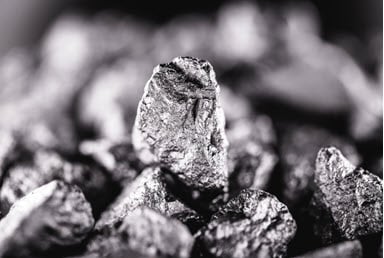Due to the lack of reliable information and complexity of the supply chain, artisanal mining is typically far more challenging to track as a source of supply than traditional mining sources. However, it is a key mechanism in keeping the cobalt market balanced during times of supply shortage.
CRU’s analysis suggests that artisanal mining supply has exhibited enormous growth in recent years to bridge the gap in supply left by curtailed copper and nickel projects, and while it may begin to decline in the coming years we expect it to continue to act as the swing producer in the long-term.
Artisanal mining – a vital industry to many
It is believed that as many as 100,000 diggers, sorters and washers are likely to be involved in the artisanal mining trade in the DRC. Artisanal miners often work independently and sell their ore to local co-operatives who then sell it to local merchants and traders, who in turn sell to international traders or operating mines that have established transport links. Traditionally, this ore has been exported to China as concentrate with minimal processing occurring in the DRC. However, an increasingly large volume of artisanal units is now bought and processed within the DRC in cobalt hydroxide plants, with many Chinese- and Indian-run mining operations subsidising their own mined supply with artisanal units.
Source: CRU
The controversy of artisanal mining
Artisanal mining is not uncommon across the wider mining industry and has been widely utilised to great effect in other mining industries such as tin and tantalum. When done correctly, artisanal mining can be an ethical source of low-cost, high-grade cobalt which also puts income directly into the hands of locals with very few alternative options available to them. However, the fundamental challenge of artisanals continues to be the complete lack of traceability involved. The large number of steps involved between mining ore and a finished refined product makes auditing artisanal supply chains near impossible, which increases the risk of unethical cobalt from child labour and unsafe sources. For this reason, western companies have sought to distance themselves from artisanal cobalt supply in the past to forego the risk of inadvertently using raw materials sourced from child labour, which remains rampant in central Africa. In 2014, UNICEF estimated that around 40,000 children were involved in the artisanal mining sector in the DRC.
Controversies also abound regarding the amount of money made by the artisanal miners themselves. Information on artisanal mining payables are difficult to track, but one article published in February of this year suggests that payables were in the region of $7,000 per tonne for 15% cobalt concentrate and $500 per tonne of 3% cobalt concentrate. Assuming a market price in China of approximately $69,000/t, this is equivalent to a payable of around 10% for high-grade material and less than 1% for low-grade material. These concentrates are often sold at a market payable in the region of 50% cobalt contained, meaning that miners only receive a tiny fraction of the value of their ore with most of it being split between traders and middlemen.
Artisanal supply rapidly accelerated in 2017
CRU has published an annual assessment of artisanal cobalt supply since 2010. Traditionally we have used a wide range of different data sources to produce our assessment of artisanally-mined cobalt production, including official DRC Chamber of Mines statistics, Chinese tradeflow data, information on individual companies and estimates given by our contacts based in the DRC. We have recently added to this with on-the-ground analysis of cobalt and copper supply chains in the DRC in June and July of this year, which has given us unique insight into the operations in the DRC and the supply chain of artisanal units.
Source: CRU
Prior to 2017, we believe that artisanal supply of cobalt was largely in decline. A relative abundance of cobalt metal and high material inventories led to persistently low cobalt metal prices from 2010 to 2016, and combined with low payables this resulted in very low profitability for most traders of artisanal ore. Given that the average trader of artisanally-mined cobalt concentrates may get a 50% payable for supply (DDP China), and given the average cobalt price in 2015 was just $13.84/lb this resulted in an average revenue of just $7/lb of cobalt contained before allowing for all related costs such as freight, salaries, payables to the miners and so on. However, this changed rapidly in 2017.
- A combination of cobalt metal shortages and investor stockpiling led to the cobalt price doubling within 6 months, from $15/lb to over $30/lb.
- At the same time, demand for cobalt in batteries continued to grow strongly, leading to a shortage of cobalt intermediates in the Chinese refinery sector, leading to increased payables as refineries scrambled to find units.
CRU understands that payables for artisanal concentrate rose as high as 60% due to shortages in the Chinese refinery sector. Combined with a higher cobalt price, this resulted in average artisanal trader netbacks rising from just $7/lb in 2016 to $18/lb in 2017 – a 150% increase. At the market’s peak of $44/lb, traders would have been making well over $20/lb.
Artisanal cobalt bridged the supply gap left by 2016
This increase in artisanal profitability led to a veritable “gold rush” in the DRC, and CRU analysis suggests that artisanal supply has been instrumental in bridging the supply gap in the past 18 months. Global mined supply dropped by 3.2% to 109,026 tonnes in 2016 following several years of stagnant supply growth, as lower copper and cobalt prices led to reduced run rates at a large number of copper projects in the DRC including Metal Mines, Big Hill, Huayou, Jinchuan and Shituru. This was compounded by reduced output due to the shutdown of Votorantim’s Tocantins mine in Brazil and the temporary closure of Glencore’s Katanga mine. As a result, the cobalt market re-entered a supply deficit in 2016 following several years of oversupply.
As this deficit continued into 2017 and supply from other mining projects waned, artisanal supply rapidly increased in reaction to higher payables and a strong cobalt price – rising from just 6,500 tonnes in 2016 to over 19,000 tonnes in 2017. This contributed to the market remaining relatively well-balanced, contrary to popular opinion. We expect artisanal supply to increase substantially y/y in 2018 as artisanal mining has continued to be a key source of supply in the first half of this year.
However, as large projects begin like Katanga, RTR and Mutoshi begin to ramp up in 2019, we expect artisanal supply to be partially squeezed out of the market by reduced payables and a reduced appetite for artisanals due to increased ethical and environmental concerns in China.
Source: CRU
Cobalt’s classification as a “by-product” is inaccurate
Traditionally, one of the key pieces of rhetoric heard in the cobalt market has been that cobalt’s status as a by-product of copper and nickel mining makes supply naturally disconnected from demand, making cobalt more susceptible to supply shocks than other commodities. However, our analysis suggests that this hypothesis is not entirely true. In times of scarcity of intermediates, the artisanal mining sector can rapidly increase production and act as the “swing tonnage” of the market, softening the effect of production curtailment in other mining sectors.
This is one of the contributing factors to why we do not believe that the cobalt market will face large-scale deficits in the immediate future. However, CRU’s price forecast does remain relatively positive over the next 5 years due to the potential of bottlenecks in the refined supply sector due to the mis-match of investment cycles.














